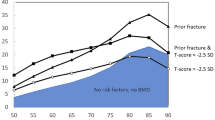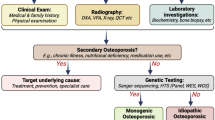Abstract
Summary
In a cohort of 393 Chinese women, by using high-resolution peripheral quantitative computed tomography (HR-pQCT), we found that significant cortical bone loss occurred after midlife. Prominent increase in cortical porosity began at the fifth decade but reached a plateau before the sixth decade. Trabecular bone loss was already evident in young adulthood and continued throughout life.
Introduction
This study aimed to investigate age-related differences in volumetric bone mineral density (vBMD), microarchitecture, and estimated bone strength at peripheral skeleton in Chinese female population.
Methods
In a cross-sectional cohort of 393 Chinese women aged 20–90 years, we obtained vBMD, microarchtecture, and micro-finite element-derived bone strength at distal radius and tibia using HR-pQCT.
Results
The largest predictive age-related difference was found for cortical porosity (Ct.Po) which showed over four-fold and two-fold differences at distal radius and tibia, respectively, over the adulthood. At both sites, cortical bone area, vBMD, and thickness showed significant quadratic association with age with significant decrease beginning after midlife. Change of Ct.Po became more prominent between age of 50 and 57 (0.26 %/year at distal radius, 0.54 %/year at distal tibia, both p ≤ 0.001) but thereafter, reached a plateau (0.015 and 0.028 %/year, both p > 0.05). In contrast, trabecular vBMD and microarchitecture showed linear association with age with significant deterioration observed throughout adulthood. Estimated age of peak was around age of 20 for trabecular vBMD and microarchitecture and Ct.Po and age of 40 for cortical vBMD and microarchitecture. Estimated stiffness and failure load peaked at mid-30s at the distal radius and at age 20 at distal tibia.
Conclusions
Age-related differences in vBMD and microarchitecture in Chinese women differed by bone compartments. Significant cortical bone loss occurred after midlife. Prominent increase in Ct.Po began at the fifth decade but appeared to be arrested before the sixth decade. Loss of trabecular bone was already evident in young adulthood and continued throughout life.





Similar content being viewed by others
References
Schuit SC, van der Klift M, Weel AE, de Laet CE, Burger H, Seeman E, Hofman A, Uitterlinden AG, van Leeuwen JP, Pols HA (2004) Fracture incidence and association with bone mineral density in elderly men and women: the Rotterdam Study. Bone 34(1):195–202
Stone KL, Seeley DG, Lui LY, Cauley JA, Ensrud K, Browner WS, Nevitt MC, Cummings SR (2003) BMD at multiple sites and risk of fracture of multiple types: long-term results from the Study of Osteoporotic Fractures. J Bone Miner Res 18(11):1947–1954
Seeman E (2002) Pathogenesis of bone fragility in women and men. Lancet 359(9320):1841–1850
Seeman E, Delmas PD (2006) Bone quality—the material and structural basis of bone strength and fragility. N Engl J Med 354(21):2250–2261
Boutroy S, Van Rietbergen B, Sornay-Rendu E, Munoz F, Bouxsein ML, Delmas PD (2008) Finite element analysis based on in vivo HR-pQCT images of the distal radius is associated with wrist fracture in postmenopausal women. J Bone Miner Res 23(3):392–399
Varga P, Pahr DH, Baumbach S, Zysset PK (2010) HR-pQCT based FE analysis of the most distal radius section provides an improved prediction of Colles’ fracture load in vitro. Bone 47(5):982–988. doi:10.1016/j.bone.2010.08.002
Boutroy S, Bouxsein ML, Munoz F, Delmas PD (2005) In vivo assessment of trabecular bone microarchitecture by high-resolution peripheral quantitative computed tomography. J Clin Endocrinol Metab 90(12):6508–6515
Nishiyama KK, Macdonald HM, Hanley DA, Boyd SK (2013) Women with previous fragility fractures can be classified based on bone microarchitecture and finite element analysis measured with HR-pQCT. Osteoporos Int 24(5):1733–1740. doi:10.1007/s00198-012-2160-1
Vico L, Zouch M, Amirouche A, Frere D, Laroche N, Koller B, Laib A, Thomas T, Alexandre C (2008) High-resolution pQCT analysis at the distal radius and tibia discriminates patients with recent wrist and femoral neck fractures. J Bone Miner Res 23(11):1741–1750
Rozental TD, Deschamps LN, Taylor A, Earp B, Zurakowski D, Day CS, Bouxsein ML (2013) Premenopausal women with a distal radial fracture have deteriorated trabecular bone density and morphology compared with controls without a fracture. J Bone Joint Surg Am 95(7):633–642. doi:10.2106/JBJS.L.00588
Sornay-Rendu E, Boutroy S, Munoz F, Delmas PD (2007) Alterations of cortical and trabecular architecture are associated with fractures in postmenopausal women, partially independent of decreased BMD measured by DXA: the OFELY study. J Bone Miner Res 22(3):425–433
Vilayphiou N, Boutroy S, Szulc P, van Rietbergen B, Munoz F, Delmas PD, Chapurlat R (2011) Finite element analysis performed on radius and tibia HR-pQCT images and fragility fractures at all sites in men. J Bone Miner Res 26(5):965–973
Dalzell N, Kaptoge S, Morris N, Berthier A, Koller B, Braak L, van Rietbergen B, Reeve J (2009) Bone micro-architecture and determinants of strength in the radius and tibia: age-related changes in a population-based study of normal adults measured with high-resolution pQCT. Osteoporos Int 20(10):1683–1694
Hansen S, Shanbhogue V, Folkestad L, Nielsen MM, Brixen K (2014) Bone microarchitecture and estimated strength in 499 adult Danish women and men: a cross-sectional, population-based high-resolution peripheral quantitative computed tomographic study on peak bone structure. Calcif Tissue Int 94(3):269–281. doi:10.1007/s00223-013-9808-5
Khosla S, Riggs BL, Atkinson EJ, Oberg AL, McDaniel LJ, Holets M, Peterson JM, Melton LJ 3rd (2006) Effects of sex and age on bone microstructure at the ultradistal radius: a population-based noninvasive in vivo assessment. J Bone Miner Res 21(1):124–131
Macdonald HM, Nishiyama KK, Kang J, Hanley DA, Boyd SK (2011) Age-related patterns of trabecular and cortical bone loss differ between sexes and skeletal sites: a population-based HR-pQCT study. J Bone Miner Res 26(1):50–62. doi:10.1002/jbmr.171
Burghardt AJ, Kazakia GJ, Ramachandran S, Link TM, Majumdar S (2010) Age- and gender-related differences in the geometric properties and biomechanical significance of intracortical porosity in the distal radius and tibia. J Bone Miner Res 25(5):983–993. doi:10.1359/jbmr.091104
Liu XS, Walker MD, McMahon DJ, Udesky J, Liu G, Bilezikian JP, Guo XE (2011) Better skeletal microstructure confers greater mechanical advantages in Chinese-American women versus white women. J Bone Miner Res 26(8):1783–1792. doi:10.1002/jbmr.378
Walker MD, McMahon DJ, Udesky J, Liu G, Bilezikian JP (2009) Application of high-resolution skeletal imaging to measurements of volumetric BMD and skeletal microarchitecture in Chinese-American and white women: explanation of a paradox. J Bone Miner Res 24(12):1953–1959
Boutroy S, Walker MD, Liu XS, McMahon DJ, Liu G, Guo XE, Bilezikian JP (2014) Lower cortical porosity and higher tissue mineral density in Chinese American versus white women. J Bone Miner Res 29(3):551–561. doi:10.1002/jbmr.2057
Hernandez ER, Seco C, Revilla M, Villa LF, Cortes J, Rico H (1996) Changes in the cortical and trabecular bone compartments with different types of menopause measured by peripheral quantitative computed tomography. Maturitas 23(1):23–29
Engelke K, Stampa B, Timm W, Dardzinski B, de Papp AE, Genant HK, Fuerst T (2012) Short-term in vivo precision of BMD and parameters of trabecular architecture at the distal forearm and tibia. Osteoporos Int 23(8):2151–2158. doi:10.1007/s00198-011-1829-1
Buie HR, Campbell GM, Klinck RJ, MacNeil JA, Boyd SK (2007) Automatic segmentation of cortical and trabecular compartments based on a dual threshold technique for in vivo micro-CT bone analysis. Bone 41(4):505–515
Burghardt AJ, Buie HR, Laib A, Majumdar S, Boyd SK (2010) Reproducibility of direct quantitative measures of cortical bone microarchitecture of the distal radius and tibia by HR-pQCT. Bone 47(3):519–528
van Rietbergen B, Weinans H, Huiskes R, Odgaard A (1995) A new method to determine trabecular bone elastic properties and loading using micromechanical finite-element models. J Biomech 28(1):69–81
Pistoia W, van Rietbergen B, Lochmuller EM, Lill CA, Eckstein F, Ruegsegger P (2002) Estimation of distal radius failure load with micro-finite element analysis models based on three-dimensional peripheral quantitative computed tomography images. Bone 30(6):842–848
Riggs BL, Melton LJ, Robb RA, Camp JJ, Atkinson EJ, McDaniel L, Amin S, Rouleau PA, Khosla S (2008) A population-based assessment of rates of bone loss at multiple skeletal sites: evidence for substantial trabecular bone loss in young adult women and men. J Bone Miner Res 23(2):205–214. doi:10.1359/jbmr.071020
Bousson V, Bergot C, Meunier A, Barbot F, Parlier-Cuau C, Laval-Jeantet AM, Laredo JD (2000) CT of the middiaphyseal femur: cortical bone mineral density and relation to porosity. Radiology 217(1):179–187. doi:10.1148/radiology.217.1.r00se11179
McCalden RW, McGeough JA, Barker MB, Court-Brown CM (1993) Age-related changes in the tensile properties of cortical bone. The relative importance of changes in porosity, mineralization, and microstructure. J Bone Joint Surg Am 75(8):1193–1205
Zebaze RM, Ghasem-Zadeh A, Bohte A, Iuliano-Burns S, Mirams M, Price RI, Mackie EJ, Seeman E (2010) Intracortical remodelling and porosity in the distal radius and post-mortem femurs of women: a cross-sectional study. Lancet 375(9727):1729–1736. doi:10.1016/S0140-6736(10)60320-0
Brockstedt H, Kassem M, Eriksen EF, Mosekilde L, Melsen F (1993) Age- and sex-related changes in iliac cortical bone mass and remodeling. Bone 14(4):681–691
Bouxsein ML, Myburgh KH, van der Meulen MC, Lindenberger E, Marcus R (1994) Age-related differences in cross-sectional geometry of the forearm bones in healthy women. Calcif Tissue Int 54(2):113–118
Maggio D, Pacifici R, Cherubini A, Simonelli G, Luchetti M, Aisa MC, Cucinotta D, Adami S, Senin U (1997) Age-related cortical bone loss at the metacarpal. Calcif Tissue Int 60(1):94–97
Thompson DD (1980) Age changes in bone mineralization, cortical thickness, and haversian canal area. Calcif Tissue Int 31(1):5–11
Finkelstein JS, Sowers M, Greendale GA, Lee ML, Neer RM, Cauley JA, Ettinger B (2002) Ethnic variation in bone turnover in pre- and early perimenopausal women: effects of anthropometric and lifestyle factors. J Clin Endocrinol Metab 87(7):3051–3056. doi:10.1210/jcem.87.7.8480
Liu XS, Cohen A, Shane E, Yin PT, Stein EM, Rogers H, Kokolus SL, McMahon DJ, Lappe JM, Recker RR, Lang T, Guo XE (2010) Bone density, geometry, microstructure, and stiffness: Relationships between peripheral and central skeletal sites assessed by DXA, HR-pQCT, and cQCT in premenopausal women. J Bone Miner Res 25(10):2229–2238
Riggs BL, Wahner HW, Dunn WL, Mazess RB, Offord KP, Melton LJ 3rd (1981) Differential changes in bone mineral density of the appendicular and axial skeleton with aging: relationship to spinal osteoporosis. J Clin Invest 67(2):328–335. doi:10.1172/JCI110039
Yeni YN, Brown CU, Wang Z, Norman TL (1997) The influence of bone morphology on fracture toughness of the human femur and tibia. Bone 21(5):453–459
Qin L, Au SK, Chan KM, Lau MC, Woo J, Dambacher MA, Leung PC (2000) Peripheral volumetric bone mineral density in pre- and postmenopausal Chinese women in Hong Kong. Calcif Tissue Int 67(1):29–36
Yuen KW, Kwok TC, Qin L, Leung JC, Chan DC, Kwok AW, Woo J, Leung PC (2010) Characteristics of age-related changes in bone compared between male and female reference Chinese populations in Hong Kong: a pQCT study. J Bone Miner Metab 28(6):672–681. doi:10.1007/s00774-010-0170-7
Qin L, Choy WY, Hung VWY, Au SK, Chan KM, Leung KS, Cheung WH, Lam TP, Cheng JCY (2014) Age-related vessel calcification at distal extremities is a risk factor of osteoporosis. J Orthop Transl 2(1):43–48
Yu W, Qin M, Xu L, van Kuijk C, Meng X, Xing X, Cao J, Genant HK (1999) Normal changes in spinal bone mineral density in a Chinese population: assessment by quantitative computed tomography and dual-energy X-ray absorptiometry. Osteoporos Int 9(2):179–187. doi:10.1007/s001980050133
Khosla S, Riggs BL, Robb RA, Camp JJ, Achenbach SJ, Oberg AL, Rouleau PA, Melton LJ 3rd (2005) Relationship of volumetric bone density and structural parameters at different skeletal sites to sex steroid levels in women. J Clin Endocrinol Metab 90(9):5096–5103. doi:10.1210/jc.2005-0396
Acknowledgments
This work was supported by Health and Medical Research Fund, Food and Health Bureau, Hong Kong SAR (Ref. 12130841).
Conflicts of interest
Hung VW, Zhu TY, Cheung WH, Fong TN, Yu FW, Hung LK, Leung KS, Cheng JCY, Lam TP, and Qin L declare that they have no conflict of interest.
Ethical approval
This study was conducted with the approval of the Joint Chinese University of Hong Kong-New Territories East Cluster Clinical Research Ethics Committee (Ref. No.: CRE-2010.153).
Author information
Authors and Affiliations
Corresponding authors
Additional information
T. Y. Zhu is the co-first author.
Electronic supplementary material
Below is the link to the electronic supplementary material.
ESM 1
(DOCX 19 kb)
Rights and permissions
About this article
Cite this article
Hung, V.W.Y., Zhu, T.Y., Cheung, WH. et al. Age-related differences in volumetric bone mineral density, microarchitecture, and bone strength of distal radius and tibia in Chinese women: a high-resolution pQCT reference database study. Osteoporos Int 26, 1691–1703 (2015). https://doi.org/10.1007/s00198-015-3045-x
Received:
Accepted:
Published:
Issue Date:
DOI: https://doi.org/10.1007/s00198-015-3045-x




